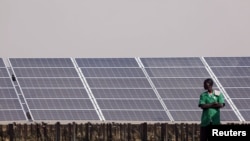The African Development Bank held a virtual conference this week focused on solar energy in the Sahel region.
Experts at the African Energy Market Place (AEMP) forum say the vast semi-arid region separating the Sahara Desert on the north and tropical savannas on the south has high solar energy potential, but poor infrastructure and funding remain challenges.
Maman Sambo Sidikou, executive secretary of the G5 Sahel, speaking in Abuja, said the countries — which include Burkina Faso, Chad, Mali, Mauritania, and Niger — are not exploiting solar energy as they should.
With a cumulative gross domestic product close to $53 billion, and a large part of the territory benefiting from stable and consistent sunshine, the G5 Sahel is the ideal region to demonstrate the power of solar energy, Sidikou said.
Challenges
However, installing solar energy requires not just solar panels, but batteries, inverters, and power regulators, and maintaining and repairing the network requires the knowledge of skilled technicians.
This is a challenge in the Sahel, where infrastructure is lacking.
Grégoire Gailly, who manages the Green Business Area program at Geres, a non-governmental organization working to battle climate change and global warming, said there are a lot of solar energy products that have been distributed in the past few years but the quality is not always there.
And sometimes, he added, it’s the installation that is not well done because some electricians are not trained in these techniques.
Access to the necessary materials can also be difficult, particularly in rural areas.
In addition, the upfront costs keep solar energy financially inaccessible to most of the population.
Power outages
Yanick Kemayou, the founder of Kabakoo Academies, a learning space in Bamako, Mali, knows firsthand the benefits of solar energy.
The building that is home to Kabakoo was intentionally built in one of Bamako’s poor, dense neighborhoods, in order to be accessible to all of the population.
But in poor neighborhoods, Kemayou explained, power outages are even more frequent than elsewhere.
Kabakoo Academies is now 100 percent powered by solar power.
“When we started Kabakoo, we were actually on the grid,” Kemayou said. “But we realized that we had productivity losses up to 70% in the rainy season, because like six to seven out of 10 scheduled activities, scheduled workshops, boot camps, would have to be canceled because of power outages.”
Electric power outages are a major problem in all of the G5 Sahel countries.
Generators
However, for those with the means to pay for solutions, solar power is not yet widely accepted as a viable solution to frequent power cuts.
Many prefer to buy generators which, like investments in solar energy, are costly.
“Why are people nowadays in Bamako, in Mali, still buying generators? This is a big question, and I have to admit I don’t have the answer,” Kemayou said. “I would love to have the answers. It seems that the population, the people here would know that solar energy exists.”
Aside from the challenges inherent in establishing a network of solar energy, most of the countries that make up the G5 Sahel have also been struggling with an ongoing Islamist insurgency.
Mali is facing political instability, with former president Ibrahim Boubacar Keita ousted in an August coup.
This year’s AEMP focus on the Sahel was in the context of the African Development Bank’s desert-to-power initiative. The program’s goal is to develop 10 gigawatts of solar energy and supply 250 million people with green, clean electricity by 2025.









